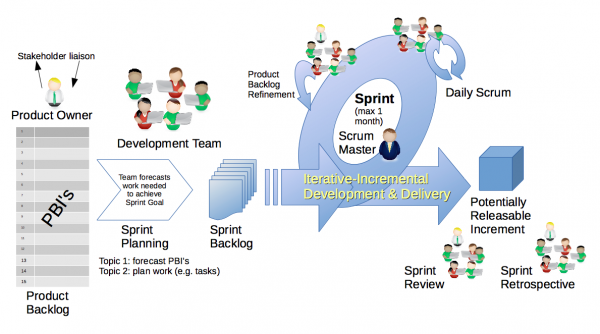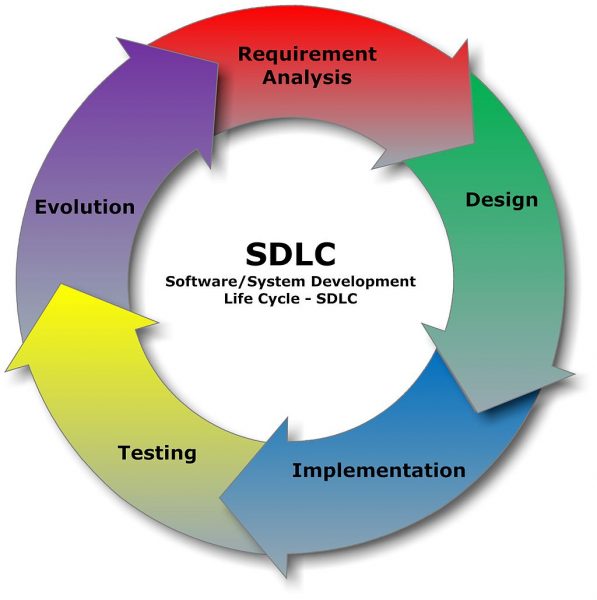The popularity of different agile methodologies is another manifestation of how busy software development is and has seldom idle moments. This is mainly because of the huge risk of competition among businesses and software providers.
It has come to a point that the saying “The things that you did not know will not hurt you!” is not applicable anymore. Instead, “the things that you did not know will eventually kill you” is the new trend. One great example of this is the adaptation of agile methodologies. Wherein software professionals prefer the right tools over wisdom.
Software development life cycle development evolved in such a manner that agile methodologies were created to be on par with the advent of ideal software solutions and applications. Both software providers and business owners agreed that using agile is not where the process ends. Instead, it is where it starts in software development. This is because agile is a continuous development with an optimistic goal by creating efforts beyond the contract.
The introduction of agile management provides less obfuscation among stakeholders. Over the years, the agile method tends to work best with its two primary ingredients: determination and effort among stakeholders. The project owner works with the business goals, and in parallel; the software providers work with the project goals. The best part is there is no shortage of tools in agile methodologies. As every method is unique and can be used by following the needed software requirements.
The agile model is can be very fascinating. But before we go into the details of the different methodologies, let’s have an overview of the Agile Manifesto.


The Agile Manifesto
Superheroes do exist, and in the world of software development, 17 superheroes met at the Snowbird ski resort in Utah in 2001. Just like in the fantasy world were heroes and villains thrive, these superheroes combined forces and created the Agile manifesto.
Since we mentioned heroes and villains, let’s examine who are the villains in the world of software development. As our fictional story began to unfold, it was known that Lord of Project Delays; obviously our villain in the story, was feared by all.
Before we can identify the different agile methodologies, most project managers at one time or another must come across the ferocious Lord. This monster can lengthen the project’s timeline as if it is never-ending. Its evil power fuels the growing list of specifications added to the original proposal. Thus, the villain successfully expands the development calendar with the aftereffect of ruining the planning. Ultimately, exhausting all the efforts and stopping a possible high Return of Investment (ROI).
Our superheroes who experienced the wrath of the Lord of Project Delays gathered and decided that there had to be a way to battle this monstrosity.
Thus, the agile manifesto was created, with the main philosophy of creating balance. Balance wherein there is value in the items on the right as we value the items on the left. The terms right and left equate to the degree of collaboration between product owners and developers. And agile project management allows both sides to better understand the goals of each other.
Here are four important aspects of the agile manifesto that eventually led to the downfall of the Lord of Project Delays. Also, the IT professionals who religiously follow the manifest will help businesses keep up with market changes and demands.
-
Constant communication over process and tools
Daily and direct communication among stakeholders mean interpersonal communication. The close communication among team members and the product owner is a vital approach to resolve the required resources and solutions. Hence, the constant customer involvement allows the predetermined duration of all the tasks and efforts resulting in frequent deliveries.
-
Working software over comprehensive documentation
The agile methodology supports incremental and iterative development, and working software is favored over comprehensive documentation. And agile promotes the total absence of documentation. However, all the stakeholders must agree on the amount and kind of documents to create and retain. As it promotes less documentation over a comprehensive design.
-
Customer collaboration over contract negotiation
Agile management promotes efficient customer collaboration. It must be noted that the word “customer” is not solely an outside client but also an in-house customer such as your CEO or maybe one of your department heads.
Contract negotiation is the favorite of the Lord of Project Delays before the birth of the agile model as there is no convergence between analysis and planning. Thus, customer collaboration is preferred over constant truce about the software product’s specifications.
-
Responding to change over following a plan
The agile management can quickly respond to change in the business market. By releasing the project in chunks, the team is capable to identify the most important items. Every other addition of new features manifests of adding value to the project.
By all means, Agile manifesto changed the landscape of software development as different agile methodologies became part of the process. Each methodology has its unique mixture of attributes, practices, terminologies, and tactics. However, it has the same overarching philosophy based on agile manifesto stipulations presented in 2001.
Seven Agile Methodologies and its Best Practices
1. XP or EXTREME PROGRAMMING
In an agile development cycle, there are two levels of the ceremony: high and low ceremony. Extreme Programming — quite the opposite of its name — being one of the most commonly used agile methods has the lowest ceremony. It allows the team to execute changes quickly.
Its best practices include the very short iterations that may take up from one week to a month. Besides, XP allows programmers the freedom to choose what agile practices to apply based on the project’s requirements. And this promotes confidence even during complicated agile processes. In XP manifests, there are four core values and that includes — courage, communication, feedback, and simplicity. Also, remember the terms associated with its roles, it includes coach, programmer, customer, and tracker.


2. SCRUM
The agile scrum framework is famous in software development. Mainly because of its best practices and its flexibility. Scrum iteration a.k.a sprint wherein the development team has the flexibility to create sprints.
Most sprint’s time frame is two weeks wherein production release is mostly in the middle of the week. A team may have up to nine members or it varies according to the size of the project. There are three roles associated with the scrum methodology: scrum master, product owner, and team member.
These roles contribute to the best practices of the scrum methodology. The scrum master is the leader who is the overall responsibility for the project and its team members. The good thing about scrum is its autonomous style, and the team leader is not the typical domineering boss since teams are self-governing.
The scrum master’s role is to lead the detection and elimination of obstacles, creating a progress report, and leading the team on how to prioritize tasks.
The product owner represents the client whether the actual owner of the project or their representative. It can also be a member of the company like the HR director in the case of in-house software projects. The team member refers to the software development team. It includes software architects, developers, database managers, and QA and testers.
3. FEATURE DRIVEN DEVELOPMENT (FDD)
This agile methodology consists of five best practices:
-
Development of an overall model
To start a project, the team must consolidate all the information gathered from Subject Matter Experts (SMEs) to create a domain model. It is basically creating the whole picture of the entire project. To simplify everything, FDD is an example of an agile unified process model that creates a plan for the necessary resources.
-
Building a feature list
Once the overall model is established, it will result in a feature list. That includes all the major features and sub-features.
-
Planning by feature
Once all the major features are identified and had been agreed by stakeholders, feature planning will start. This is the start of the two-week iteration process. During the planning, if a feature is found to be built in more than two weeks, it will then be broken down into smaller features.
-
Designing by feature
In each feature, each team member owns its unique code. This is one of the best practices of FDD.
-
Building by feature
Through this process, FDD achieves its goal to deliver tangible, working software on time, repeatedly. This is the last stage of the two-week iteration wherein all members, up to nine roles cohesively collaborate to deliver tangible features every two weeks.
4. KANBAN
As a successful development from Toyota, Kanban is an approach that is still functioning within Toyota to manage its production and delivery of parts inside their factories. In manufacturing, Kanban itself is a card, which is attached to the parts of the vehicles. Toyota then uses these cards to track their productions within their factories.
Using Kanban in software development, it covers a defined scope. When work is split into small pieces, the scope is clearer. This is because these small pieces correspond to a workflow or the amount of effort to accomplish these small pieces of work. As a result, the workflow must be in smaller pieces of work by standardizing the average completion time for a refined piece of work. Kanban works in a way to define lead time as accurately as possible to avoid delays.


5. LEAN SOFTWARE DEVELOPMENT
Lean software development is an agile methodology derived from Toyota’s lean manufacturing system. Mainly because Toyota is famous for its highly efficient process for building as many cars in little time and minimizing wastes.
Here are seven best practices of lean software development:
Eliminate waste
Waste is anything that is not valuable inside the software development. Project managers are responsible to identify and eliminate these wastes. These include unnecessary resources, work, functionality, and tools.
Amplify learning
Learning will never stop inside the software development. But, learning is not gaining new skills either. Instead, amplifying the learning process focuses on the development of the software. Team members gain knowledge about the software from constant communication and collaboration among team members, testing and client’s experience and perspective.
Decide as late as possible
Being impulsive is not an ideal agile methodology practice especially in lean software development. Decisions should be flexible as requirements may change at any given time.
Deliver as soon as possible
Late deliveries cause frustrations from both parties of the software development whereas an on-time submission is a great delight. A small delay in one feature may escalate and creates a huge backlog for the entire development.
Empower the team
One of the best practices of Lean software development is to empower each member of the team to contribute. Since all members have the right the voice out, their suggestions are valuable in the case of finding solutions to problems. Team leaders are responsible for addressing the order and promotes teamwork to achieve a great result.
Build integrity
We believe a product reflects your integrity. A satisfied customer is a reflection of a well-built software with superb functionalities. You are not just building software, you are building your reputation in the software development arena, and your integrity lies on the product that you delivered.
See as a whole
Software development starts with the whole picture wherein it is decomposed into smaller features and functionalities. This is done to eliminate defects that tend to accumulate every time codes are pushed and merged. To satisfy the end-users, lean development of software offers fast delivery, eliminating waste and follows strict costing, every time.
6. CRYSTAL
The crystal methodology is an agile framework that promotes teamwork, constant communication, and simplicity. It has the same attributes as the agile methodologies, discussed earlier. Its core practices include its frequent delivery of working software, adaptability to changes and high user involvement.
Crystal’s primary goal is of using people and their interaction to deliver software accurately. Though it does not try to enhance tools or techniques, the development keeps the collaboration of people and its processes as its best practice. Ultimately, the interaction between members and how they collaborate to achieve an agile unified process is what crystal methodology is all about.
7. DYNAMIC SYSTEM DEVELOPMENT METHOD (DSDM)
It is an agile framework that promotes quick software delivery. Quick but not faulty. The DSDM methodology evolves to provide efficient planning, managing, scaling, and iterative software development. It covers eight key principles as a guiding beacon to the team. And DSDM adheres to the strict compliance of these principles as not to undermine the outcome.
DSDM’s Eight Key Principles:
- Focus on the business need
- Deliver on time
- Collaborate
- Never compromise quality
- Build incrementally from firm foundations
- Develop iteratively
- Communicate continuously and clearly
- Demonstrate control
Conclusion
The introduction of agile methodologies types changed the way we develop software. The IT community harnessed the efforts of the 17 heroes that created the agile manifesto. Ultimately, this manifesto led to the development of agile frameworks.
Every framework has its practices and tactics but serves only one purpose – to meet the demands of the ever rapidly changing business market trends. Thus, to cope with the fast trend in software development, an IT professional must not solely focus on agile methodologies but how to use programming languages such as Java and PHP in an agile manner.

























